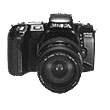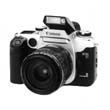 |
"Which is better: the Minolta 700si or the Canon 50e/Elan II?" |

|
|---|
A personal comparison, by Ken. K.
"I am buying a new camera hand have narrowed the choice down to either the 700si or the Canon 50e.
I see you have both cameras. Which do you prefer?"
Yes, I have both cameras and often get asked these
questions. The difficulty is that both cameras have their
pros and cons, so this not an easy question to answer.
I'll compare the two cameras and point out
those differences that I find important. I shall refer
to the Minolta as the 700si and the Canon ElanIIe/50e
(USA name and European name) simply as the 50e.
Build:
- 50e has an easily scratched silver aluminium
skin. It also has reliability problems (see below).
The battery compartment cover has a hinge made of a
thin bit of bendy plastic.
- 700si has tough scratch resistant body.
Ergonomics:
This is a matter of taste of course, but my impressions are:
- 50e is "blocky", requires bending fingers unnaturally
to operate front and rear wheels. Also, the knobs
concept is good but incomplete. It still has a multifunction
cycling button on the back with 6 functions that should have
been put on the knobs and in the custom functions. The 600si
does the knobs thing better.
- 700si feels good in the hands, and the memory function
and reprogrammable "P" button (needs custom card) allows quick
access to two favourite setups, compensating somewhat for the lack
of knobs.
Several functions are on tiny rubber buttons inside a door on
the side of the camera. Most are functions you either set
and forget ones you don't use often. But if you are using
the self timer release (because you forgot your release
cable), then this is a pain, because this function resets after
every shot.
Metering:
- 50e has a 6 segment system. You can lock the exposure
in for about 4 seconds by pressing the CF button (if custom
function 4 is set for it to do that, see later)
- 700si has 14 honeycomb segments. With the Multispot card,
it holds an exposure indefinitely, and allows you to
average out up to a maximum of 8 separate exposure measurements.
Spotmeter:
- 50e uses the centre square = 10% of picture
- 700si uses centre honeycomb = 3% of picture. When the spot
meter button is held down, a scale appears in the viewfinder.
Moving the centre spot element around the image, an arrow
on the scale shows how much brighter/darker other parts of the
image are compared to where you just spotmetered.
Vertical grips:
- 50e vgrip has a release button only.
- 700si vgrip has release, spot and AF buttons, and both
control wheels in nearly the same positions as on the camera.
It also has a PC connector.
Both vgrips take the original 2CR5 battery or 4 AA cells.
Autofocus:
- 50e's AF system is better. With the AF assist lamp off,
it focuses on subjects with lower contrast than the 700si.
The 50e has 3 sensors, the central one being a cross sensor.
The 700si has 4 elements, two vertical and two horizontal.
Left to itself, the 700si usually selects the element
that is over the nearest object, so it's better to pre-select
only one AF element. However, doing this causes AF to suffer.
- AF is switched on and off on the 50e with the AF on/off
switches on the actual lenses. The switches are very
positive. The 700si AF switch, on the other hand, takes every
opportunity to turn AF back on.
- A wonderful feature is the 50e's "full time manual"
mode. This lets you normally use the lenses in manual,
and if you need a burst of AF, you press the CF button
on the back of the camera. Unfortunately, you cannot
have DOF preview at the same time, which is available
as an either/or option on the CF programmable button.
- 50e's AF assist lamp can be disabled by custom
function no. 7. Important for candids.
You cannot switch the AF assist lamp on the 700si off
directly, but if you select one of the non-central
AF elements, the AF lamp will not light.
Bracketing:
- 50e requires cycling to AEB on the rear function button,
then choosing between 1/2 and 2 EV stop steps for the
three bracketed frames. By the time you have set this
up, you may as well have bracketed manually.
- 700si has a button allowing instant access to 1/2 EV step
3 frame bracketing. If you know you are going into a
situation needing serious bracketing, using
the Bracket2 chipcard allows 3, 5 or 7 frame, 0.3 to 1 EV
step bracketing, and even flash bracketing.
Lenses:
- I bought the 50e because I needed specific lenses, such as the
shift and tilt lenses and the new IF lenses. The silence
of the ring USM lenses may be important to wildlife
photographers.
- Canon has a wide selection of lenses, altho'
the range is a little deceiving. Many optically identical
lenses are available in different versions with micro motors,
with ultrsonic motors, with ring USMs, or with image stabilisation.
- 700si has a good (if somewhat conservative)
selection of lenses, with gaps filled in by 3rd
party lens manufacturers.
Flash:
The two cameras have different flash systems.
- The 700si supports Minolta's wireless flash system.
This is a worthwhile feature.
- The 700si has one central TTL exposure meter element,
whilst the 50e has one behind each AF field (for the
built-in flash), and E-TTL if you use the 380EX
accessory flash.
I find neither system is any better or worse. Both require
time, patience and experience to get consistent,
predictable results.
- Slow sync is done on the 700si by pressing
(and keeping pressed) the spot meter button. On the
50e, if you select Tv(S) or Av(A) modes, you automatically
have slow sync as well. I would have preferred a simple
on/off switch on both cameras.
Custom functions:
- 700si needs a custom function card.
- 50e has all custom functions on the CF position on
one the left knob.
Most functions are similar.
Important functions in the 50e that the 700si does
not have are:
- Rear-curtain flash sync enable,
- AF assist lamp disable,
- (psuedo) Mirror lock-up,
- Programmable button (set to one only of the following:
- Ex. lock and DOF-preview,
- Ex. lock and Flash exposure lock, or
- Full-time-manual AF).
Special functions:
Assuming you use your SLR a lot for point and shoot;
- 50e has sport, portrait, etc. modes on the dial.
These are extremely annoying, because they do
crazy, unexpected things, like popping up the flash
when it feels like it, setting film drive to continuous
(in portrait mode?!) and so on. Waste of space.
- The 50e has an interesting DEP feature, whereby
you focus on something near, then something far.
The camera then selects a focus and aperture combination
which tries to get both subjects in focus.
- 700si requires the less convenient chip cards, but P
mode should cover your point and shoot requirements.
- The Background Priority card is similar in concept
to the DEP function, but is not as well implemented.
- The Travel chipcard is interesting, it sets hyperfocal
distance for you automatically.
Some other chipcards worth having:
- The unique Fantasy 2 effect card,
- Panning card; which shows on a scale how steadily you
are panning a moving subject,
- the already-mentioned MultiSpot metering card and the
- Custom Functions card, as well as the
- Intervalometer card, a special card for scientific use
which offers complex self-timer functionality such as
taking one picture per day, all on its own.
Eye controlled functions.
- 700si has eye start function which starts AF as soon
as you look through the viewfinder. Probably intended
for sport. I keep it switched off.
- 50e has three AF elements that can be selected by looking
at them. You need to calibrate the camera to your eyes
first. Some people love this feature. I find I end up having
to decide which element to focus with, place it over the
subject, look at it to activate it, recompose, then shoot.
One decision extra to make.
And since only the central element is a cross sensor,
this is the one that is more likely to focus reliably.
Basically, it's a novelty that I keep switched off.
I just keep the central element permanently active. Simple.
I think it's as well to warn of the quality problems
the 50e seems to have.
The first 50e I got would jam with the mirror
locked up. This was a random fault, so of course
it never happened when the technicians tried it,
and I had to return it 5 times (with a 5-week
wait each time) before the service centre took
the problem seriously and exchanged the camera.
The camera they then gave me as a replacement
would simply stop whilst rewinding the film,
again randomly. I opened the back once during
a concert with a half-rewound film and exposed
several frames because of this.
My third replacement camera now works without any
problems. But it took 8 months and much grief
before I finally had a working camera in my hands.
My colleague at work also has a 50e. His problem is
that it is dead with certain batteries. Apparently,
the reset switch inside the battery compartment is just a
little bit too short, so that slight variations in battery
dimensions mean that some batteries just don't work.
All three problems are frequent topics on the EOS web site,
and I have seen them discussed in magazines, too, so these
were not isolated incidents. My advice is, should you choose
the 50e (it's a wonderful camera when it's working)
and one of these faults occur, tape up all knobs and
switches (to stop sales staff from playing with it
and resetting it), and demand that only a Canon technician
remove the tape. Otherwise, you'll have the same "we cannot
reproduce the fault" story I had every time.
Hope some of this helps you decide.
Ken K. (email: kenk@datanetworks.ch
), 26/8/98
HTML: Chris Valentine
Return to MUG Main Page (frames)



